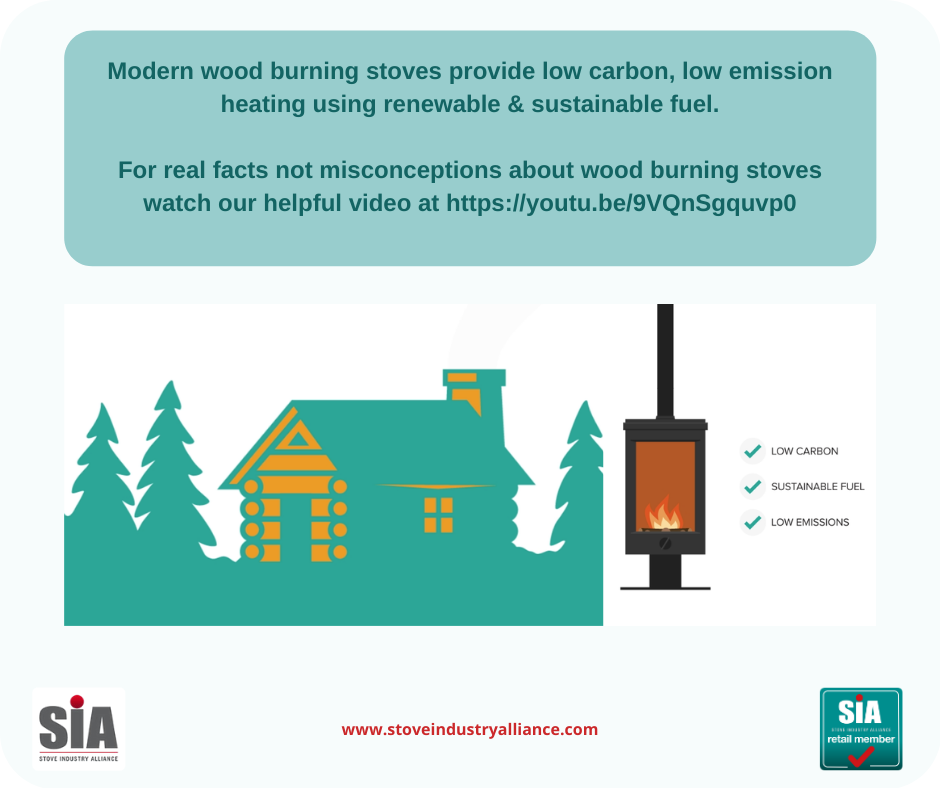A new video designed to help consumers understand the real facts about woodburning stoves has been launched by the Stove Industry Alliance (SIA).
Modern woodburning stoves and fireplaces provide low carbon and low emission heating using renewable and sustainable fuel. However, through a combination of reported misconceptions and lack of awareness, these appliances are often portrayed as negative and responsible for contributing much more particulate emissions than they actually do.
The new SIA video aims to dispel the reported myths around wood burning stoves by tackling three of the major misconceptions that surround them, to help consumers better understand their benefits and make an informed choice.
The first of these misconceptions is the notion that woodburning stoves are the biggest cause of small particulate matter in the UK. At the root of this myth is a statement within Defra’s Clean Air Strategy that says domestic combustion accounts for 38% of fine particulate matter. This number was based on a government survey in 20151 which incorrectly over-estimated the amount of wood being burnt on stoves and fireplaces in the UK.
A much larger survey carried out in 20192 showed the true figure was less than a third of what the government estimated making the percentage of PM.2.5 attributable to domestic combustion closer to 13% and NOT 38%.
In addition, the 38% figure stated by Defra is based on emissions from older stoves and open fires and we know that modern Ecodesign compliant woodburning stoves produce 66% less emissions than these outdated appliances. Defra also includes other sources of PM2.5 in its overall estimation, including bonfires, incinerators and wildfires which are significant and unregulated sources of particulate matter.
One of the most striking myths perpetuated about woodburning stoves is that they “create the same emissions as 18 diesel cars”. This comes from an interpretation of test results by the Air Quality Expert Group (AQEG), but their comparison is very misleading and, as the video points out, is like comparing apples with oranges.
Firstly, the comparison is between the appliances running at very different efficiency levels, by measuring the exhaust emissions at an efficient run rate of 21mph for the car and comparing them to all of the emissions at a full nominal run rate for a stove. This comparison therefore ignores all the small particle emissions from the car’s brakes and tyres, when frequently the emissions from a car’s brakes and tyres are actually greater than the emissions from the exhaust pipe. Finally, the difference in the dispersal point of particulate matter from cars compared to woodburning stoves is completely ignored. A car outputs its emissions at face level for a child and therefore there is very little dispersal before it is breathed in, whereas a stove will vent its emissions at the top of a chimney and there is considerable dispersal of any emissions before they are at a human height.
The final myth tackled by the SIA’s video is the idea that all woodburning stoves and fireplaces are harmful. Morley Sage, chair of the Stove Industry Alliance, explains why this is one of the more pervasive misconceptions: “This view fails to take into account the huge advances that have been made by the woodburning stove industry in recent years. Many critics of woodburning stoves base their assumptions on data linked to open fires, older stoves and poor-quality wood fuel. The SIA would be one of the first organisations to point out that burning wet wood on an open fire, a practice that is still very common today, is one of the least efficient and most highly polluting ways to heat your home. By stark contrast, a modern woodburning stoves emits up to 90% less emissions than an open fire and up to 80% less than a stove that is 10 or more years old.
SIA members were among the first manufacturers to develop the technology within their appliances to meet the forthcoming Ecodesign Regulations (SIA Ecodesign Ready), and more recently the SIA has initiated and supported the launch of clearSkies, an independent emissions and energy performance certification scheme for solid fuel stoves and fireplaces. Appliances certified under clearSkies not only meet the performance levels set out under Ecodesign, many go a significant way beyond. We would therefore encourage consumers to look for the clearSkies certification mark.
The real facts about modern woodburning stoves are that they are a future proof, highly efficient, very low carbon and sustainable way of heating our homes and keeping our families warm, and that is something to be truly proud of.”
To watch the SIA video visit: https://youtu.be/9VQnSgquvp0 and for further information on owning, using and maintaining a wood burning stove go to www.stoveindustryalliance.com
1 The BEIS Domestic Wood Survey https://www.gov.uk/government/publications/summary-results-of-the-domestic-wood-use-survey using a sample size of 1,206
2 SIA independently verified research carried out in 2019 using sample size of 10,620 using same questions as BEIS survey
